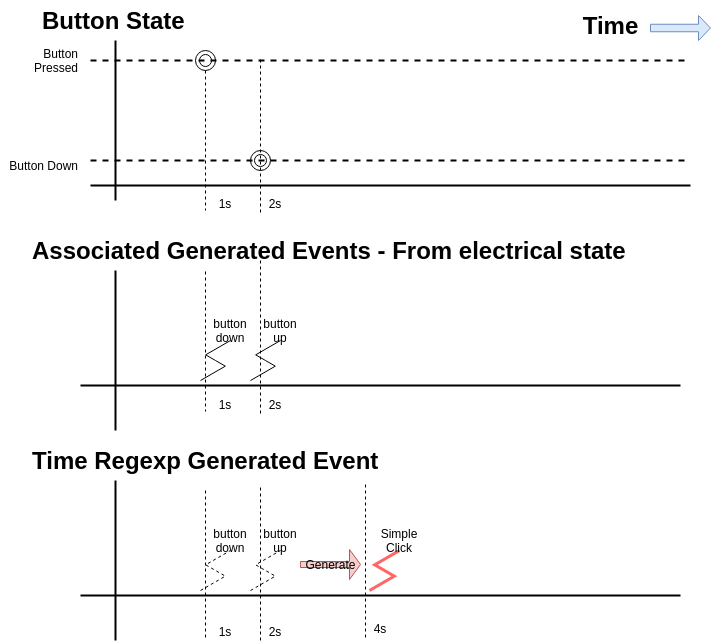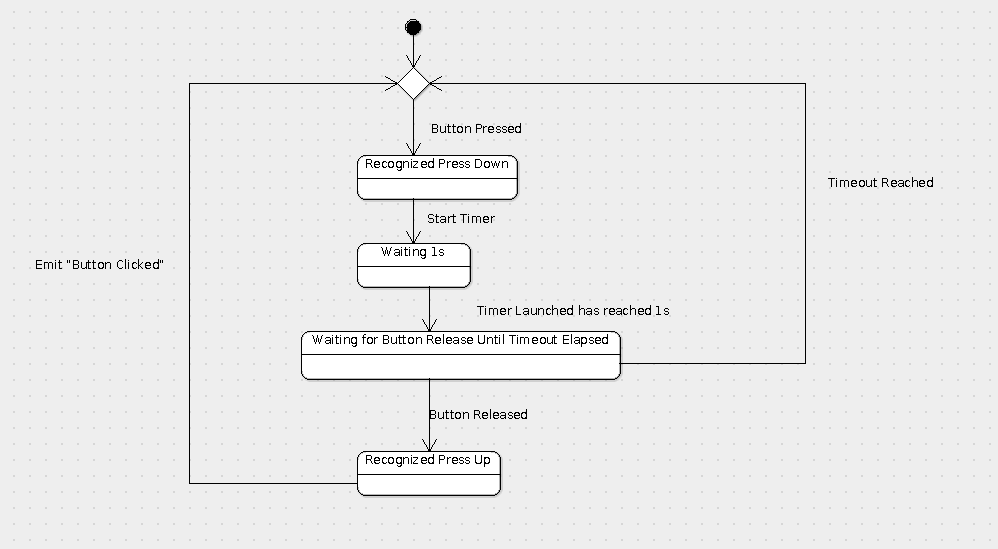Time Expression RegExp triggers to improve meaning
Compilation and Language Theory is a way to transform “Low level” informations into a more evolved action. This ability, in the ambiant and intelligent systems, leverage the summarizing sparsed actions or “events”, into a more human understandable meaning. This decomposition raise the information to a more evolved semantic that can help design more sophisticated logics.
Applications of these tools also enhance and extend already existing devices, adding timed based actions triggering. As an example, a simple device button can then understand long pressures, or fast sequences that can be transformed in different actions ( in the same way the Morse Code has been setted up in the 19th century for transmissing Textual messages, using a simple tone).
Introducing Timed Regular Expression patterns using an example
In the understanding of the Timed Regular Expression grammar, we can easily start with a simple example, and details the needs for expressing such logics.
In the proposed didactic example, a sequence of two events (up and down) on a button can be transformed to a “simple click” event.

In this example a couple of events (down and up), is synthetized into a simple event, meaning the button has been pressed once, shortly. We can see here, in this pipeline transform, that multiple events can be synthetize in a unique event representing the “button down, wait 1s, button up” evented time pattern given a unique simple click named event.
In implementation, this kind of compilation process is usually done using a finite state machine. This automata manage states in the recognition, and emit some events in some transition. In this upper case, the “simple click” generated event is triggered when the first “button down” event is fired and the second “button up” event is recognized GIVEN a minimum time lapse.
This internal automata can be represented as below, using UML representation :

We can see timeout intermediary states in automata, introducing here some time constraints for accepting properly the following “button up” event in the sequence. This insure a minimum of 1s wait between the first, and the second event recognition.
Link with time
Defining some regular expression, every events place in time must be enclosed by time segment [min - max] to be able to match practical applications.
Then, finite state machine can be constructed from regular expression introducing the timed additional states.
Introducing Timed Regular Expression grammar
Regular expression definition rely here on a EVENTPATTERN , which can be fixed given set of vocabulary defining the events either some condition to match the transition between the several states.
For simplicity reason, in this fist description, the events are part of a fixed set. Fixed event are encoded in a simple string.
TRegExp (Time regular expression) definition and model
Time pattern is expressed using a sequence of TimeTuple, expressing the start listening of the event and the wait possible time to grab the event.
TimedPattern : [ TimeTuple, TimeTuple, TimeTuple …. ]
TimeTuple: ([minTimeFromLastEvent, waitTime], EVENTPATTERN)
NOTA : times are expressed in relative time from the previous event
EVENTPATTERN: condition to match the event from ordered event queue.
Currently EVENTPATTERN is the name of the event, or use ^EVENTNAME for negation
Operators
. : sequence of timed patterns
| : alternatives, expanded in multiple patterns
{min, max} : fixed repetitions, MAX must be a fixed number
Examples :
1[0,0]BUTTONDOWN, [0.8,1.2]BUTTONUP
means a button push, with 0.8 - 1.2 button pressed time.
1[0,0]BUTTONDOWN, [0,0.8]^BUTTONUP, [0,0.4]BUTTONUP
Home automation applications
- Button enhancement for getting more commands from one device
- Multiple event conjonctions detections, correlate multiple sensors with time constraints,
- geeting to know a person is in a room
- getting to know a person is moving from several rooms
Simple Parsing python implementation
a first simple implementation of this timed event regular pattern expression is done in tregexp repository. (without operators).